| Listing 1 - 10 of 19 | << page >> |
Sort by
|
Book
ISBN: 0128005890 0128001887 9780128005897 9780128001882 Year: 2015 Publisher: Amsterdam
Abstract | Keywords | Export | Availability | Bookmark
 Loading...
Loading...Choose an application
- Reference Manager
- EndNote
- RefWorks (Direct export to RefWorks)
The Comprehensive Sourcebook of Bacterial Protein Toxins 4th Edition, contains chapters written by internationally known and well-respected specialists. This book contains chapters devoted to individual toxins, as well as chapters that consider the different applications of these toxins. Considerable progress has been made in understanding the structure, function, interaction and trafficking into cells, as well as mechanism of action of toxins. Bacterial toxins are involved in the pathogenesis of many bacteria, some of which are responsible for severe diseases in human and animals, but can al
Bacterial toxins. --- Bacterial antigens --- Microbial toxins
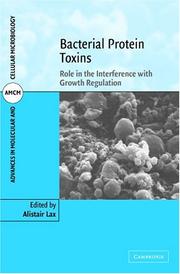
ISBN: 9780511546280 9780521820912 9780521177467 0511109687 9780511109683 0511109377 9780511109379 0511121180 9780511121180 0511546289 052182091X 1280162996 9781280162992 052182091X 1107136377 9786610162994 0511197225 0511298595 0521177464 Year: 2005 Publisher: Cambridge, UK ; New York, NY : Cambridge University Press,
Abstract | Keywords | Export | Availability | Bookmark
 Loading...
Loading...Choose an application
- Reference Manager
- EndNote
- RefWorks (Direct export to RefWorks)
Bacterial toxins that act inside cells interact very specifically with key components of the cell and some even manipulate the cell in subtle ways for their own purposes. These potent toxins, described in this 2005 book, will be of interest to both microbiologists and cell biologists. Some of these toxins are conventional multidomain toxins that are self-programmed to enter cells. Others are delivered by type III mechanisms, often as a package of potent molecules. The molecular targets for all these toxins mediate signal transduction and the cell cycle to regulate the crucial processes of cell growth, cell division and differentiation. Thus these potent toxins are not only responsible for disease, but also provide a powerful set of tools with which to interrogate the biology of the cell. In addition such toxins may act directly to promote carcinogenesis and hence their study is also of interest in a wider context.
Bacterial toxins. --- Bacterial antigens --- Microbial toxins
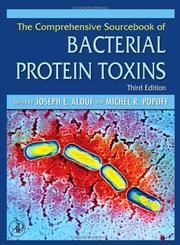
ISBN: 9780120884452 0120884453 0080456987 9780080456980 9786610628469 1280628464 Year: 2006 Publisher: Amsterdam ; Boston : Elsevier,
Abstract | Keywords | Export | Availability | Bookmark
 Loading...
Loading...Choose an application
- Reference Manager
- EndNote
- RefWorks (Direct export to RefWorks)
This book describes the major achievements and discoveries relevant to bacterial protein toxins since the turn of the new century illustrated by the discovery of more than fifty novel toxins (many of them identified through genome screening). The establishment of the three-dimensional crystal structure of more than 20 toxins during the same period offers deeper knowledge of structure-activity relationships and provides a framework to understand how toxins recognize receptors, penetrate membranes and interact with and modify intracellular substrates.* Edited by two of the most highly re
Bacterial toxins. --- Bacterial antigens --- Microbial toxins
Book
ISBN: 3038427039 Year: 2018 Publisher: Basel, Switzerland : MDPI,
Abstract | Keywords | Export | Availability | Bookmark
 Loading...
Loading...Choose an application
- Reference Manager
- EndNote
- RefWorks (Direct export to RefWorks)
Bridging cellular membranes is a key step in the pathogenic action of both binary and pore-forming bacterial toxins. The former use their translocation domains, containing various structural motifs, to ensure efficient delivery of the toxic component into the host cell, while the latter act on the cellular membrane itself. In either case, the integrity of the membrane is compromised via targeted protein-lipid and protein-protein interactions triggered by specific signals, such as proteolytic cleavage or endosomal acidification. This Special Issue presents recent advances in characterizing functional, structural and thermodynamic aspects of the conformational switching and membrane interactions involved in the cellular entry of bacterial protein toxins. Deciphering the physicochemical principles underlying these processes is also a prerequisite for the use of protein engineering to develop toxin-based molecular vehicles capable of targeted delivery of therapeutic agents to tumors and other diseased tissues.
Bacterial toxins. --- Bacterial antigens --- Microbial toxins
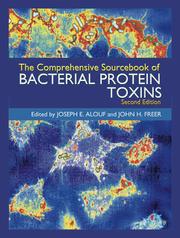
ISBN: 0120530759 Year: 1999 Publisher: London Academic press
Abstract | Keywords | Export | Availability | Bookmark
 Loading...
Loading...Choose an application
- Reference Manager
- EndNote
- RefWorks (Direct export to RefWorks)
Medical microbiology, virology, parasitology --- Bacterial toxins --- Bacterial antigens --- Microbial toxins --- Bacterial toxins.
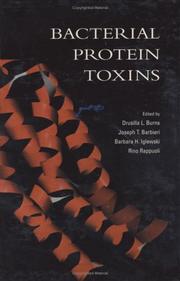
ISBN: 1555812457 Year: 2003 Publisher: Washington : ASM Press,
Abstract | Keywords | Export | Availability | Bookmark
 Loading...
Loading...Choose an application
- Reference Manager
- EndNote
- RefWorks (Direct export to RefWorks)
Bacterial toxins --- 579.6 --- 615 --- 579.6 Applied microbiology --- Applied microbiology --- Bacterial antigens --- Microbial toxins --- Pharmacology. Therapeutics. Toxicology --- Bacterial proteins
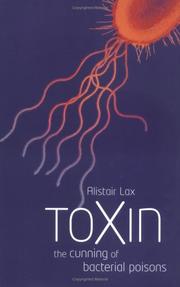
ISBN: 1280758147 0191513903 1429421568 9780191513909 9781429421560 9786610758142 661075814X 0198605587 9780198605584 0191578509 1383031223 Year: 2005 Publisher: Oxford New York Oxford University Press
Abstract | Keywords | Export | Availability | Bookmark
 Loading...
Loading...Choose an application
- Reference Manager
- EndNote
- RefWorks (Direct export to RefWorks)
Alistair Lax reveals the panoply of ways in which bacterial toxins overcome the defences in our cells. He explains how they work, how they are so successful in causing major diseases and how humans can learn to combat them, and even harness them for beneficial purposes.
Bacterial toxins --- Bacterial antigens --- Microbial toxins --- 579.61 --- 615.9 --- bacteriële toxines --- bacteriën --- biologie --- geneeskunde --- microbiologie --- pathologie --- toxicologie --- toxines --- medische microbiologie --- algemene toxicologie --- Bacterial toxins.
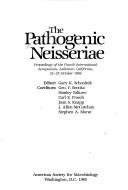
ISBN: 091482676X Year: 1985 Publisher: Washington (D.C.): American society for microbiology
Abstract | Keywords | Export | Availability | Bookmark
 Loading...
Loading...Choose an application
- Reference Manager
- EndNote
- RefWorks (Direct export to RefWorks)
Neisseria. --- Bacterial antigens --- Gonorrhea --- -Meningitis --- -Neisseria gonorrhoeae --- Neisseria meningitidis --- Meningococcus --- Meningitis --- Neisseria --- Diplococcus gonorrhoeae --- Gonococcus --- Micrococcus gonorrhoea --- Neisser's coccus --- Leptomeningitis --- Central nervous system --- Genitourinary organs --- Neisseria infections --- Sexually transmitted diseases --- Urethritis --- Antigens --- Bacteria --- Microbiology --- Diseases --- Infections --- Bacterial antigens. --- Neisseria gonorrhoeae. --- Neisseria meningitidis. --- Microbiology. --- congresses. --- Congresses. --- Neisseria gonorrhoeae
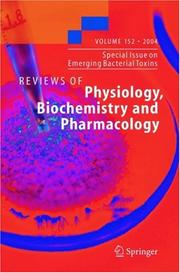
ISBN: 1281340936 9786611340933 3540271155 3540231315 Year: 2005 Publisher: Berlin, Heidelberg : Springer-Verlag Berlin Heidelberg,
Abstract | Keywords | Export | Availability | Bookmark
 Loading...
Loading...Choose an application
- Reference Manager
- EndNote
- RefWorks (Direct export to RefWorks)
(bitte wie üblich Contents nehmen).
Bacterial toxins. --- Biochemistry. --- Biological chemistry --- Chemical composition of organisms --- Organisms --- Physiological chemistry --- Biology --- Chemistry --- Medical sciences --- Bacterial antigens --- Microbial toxins --- Composition --- Medicine. --- Biomedicine general. --- Clinical sciences --- Medical profession --- Human biology --- Life sciences --- Pathology --- Physicians --- Health Workforce --- Biomedicine, general.
Book
ISBN: 9783319224558 3319224549 9783319224541 3319224557 Year: 2015 Publisher: Cham : Springer International Publishing : Imprint: Springer,
Abstract | Keywords | Export | Availability | Bookmark
 Loading...
Loading...Choose an application
- Reference Manager
- EndNote
- RefWorks (Direct export to RefWorks)
This book provides ample knowledge and better understanding of Streptococcus pyogenes and their superantigens. Many illustrations make this a highly informative book. This book elucidates briefly Streptococcus pyogenes as a strict human pathogen possessing an array of virulence factors. These help in evading host immune responses such as by the activation of non-specific T-cell subpopulations by producing superantigens. This book mainly focuses on streptococcal superantigens and explains how they are different from conventional antigens. Moreover, it elaborates those diseases in which superantigens are actively involved. Useful aspects of superantigens and different therapeutic interventions to eradicate superantigens induced diseased are also discussed.
Life Sciences. --- Microbiology. --- Life sciences. --- Sciences de la vie --- Microbiologie --- Streptococcus pyogenes. --- Superantigens. --- Biology --- Health & Biological Sciences --- Microbiology & Immunology --- Streptococcus hemolyticus --- Streptococcus --- Bacterial antigens --- Viral antigens --- Microbial biology --- Microorganisms
| Listing 1 - 10 of 19 | << page >> |
Sort by
|

 Search
Search Feedback
Feedback About UniCat
About UniCat  Help
Help News
News